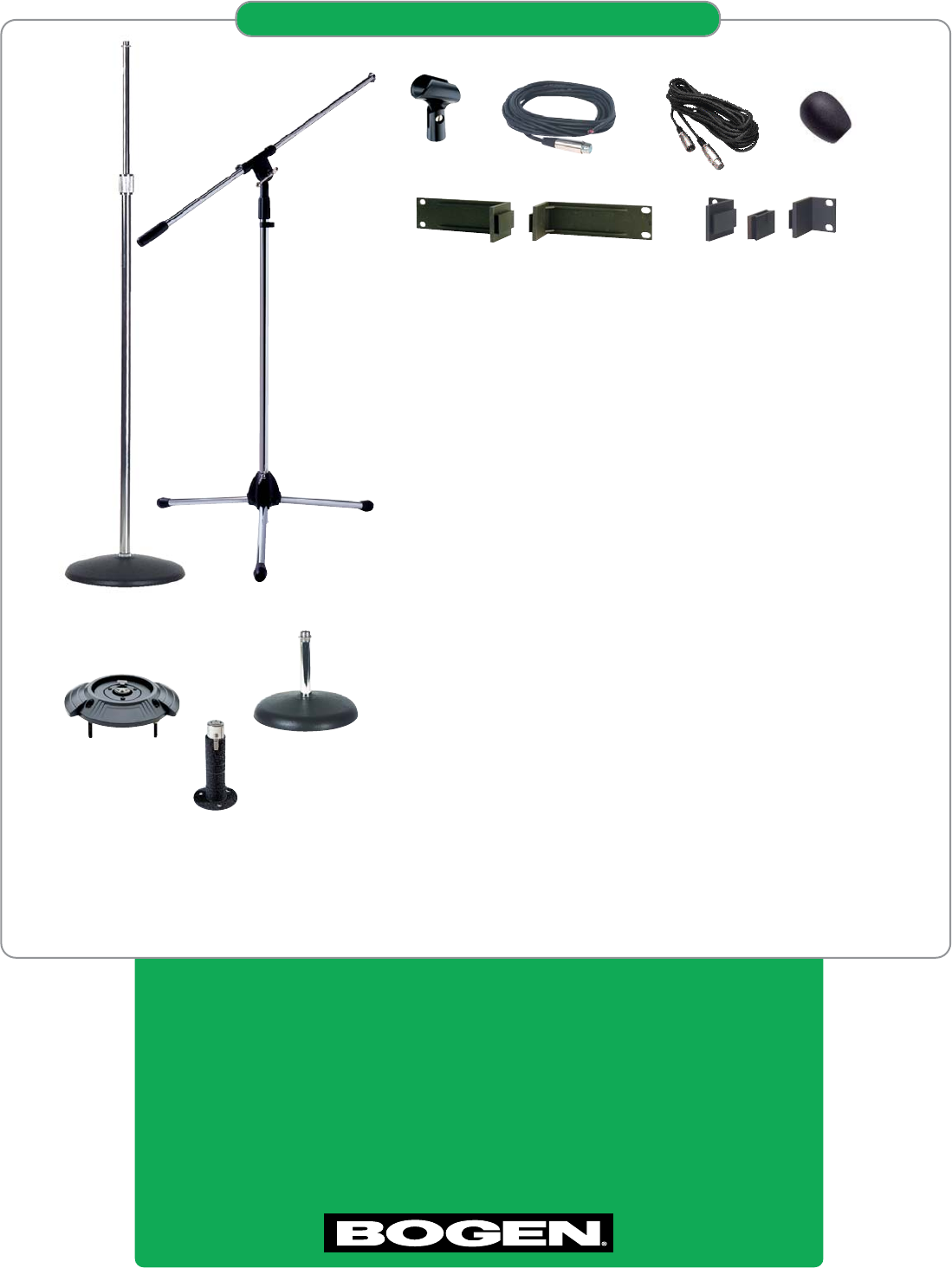
High-Quality
Microphones
Innovative Solutions for
Demanding Applications
Bogen’s selection of high-quality, portable microphones offer
clear, natural, intelligible sound. Engineered for accurate sound
reproduction, each microphone is ruggedly constructed to with-
stand the demands of sound installations. A variety of types and
styles are available including gooseneck, desktop, handheld,
wireless handheld/lavaliere, overhead hanging, and surface-
mount microphones. Both contemporary and traditional
designs provide accurate response and dependable perform-
ance, with optimum clarity.
Bogen’s microphone models are crafted with professional-
grade features, including models with rubberized grips, dent-
proof screens, and quiet on/off glide switches. In addition,
Bogen’s handheld mics feel good in the hand and reduce reso-
nance from taps and handling.
A variety of accessories are available for Bogen’s line of micro-
phones - including stands, mounting clips, and cables
.
Cardioid (Uni-Directional)
This pickup pattern is sensitive to sound coming from one
direction - in front of the microphone - thus, it best serves a
single user. It is preferred for applications where there is like-
lihood of feedback, where the ambient noise is too high or
variable for a good clear signal, or where the user will be close
to the microphone. Microphones with a cardioid pickup pat-
tern greatly reduce the chance of reproducing unwanted
sources of noise that are at the back or sides of the micro-
phone, such as with an audience.
Omni-Directional
This microphone pickup pattern is sensitive to sound from
all directions - in front, back, and on the sides of the micro-
phone - thus, best serving a group of users. Omni-direction-
al microphones are preferred for use in studios, offices,
round-table discussions, or other environments where there
is no ambient background noise (such as a conference
room). Microphones with an omni-directional pickup pattern
provide a smoother response than microphones with a car-
dioid pickup pattern.
Cardioid
0˚
180˚
330˚
60˚
300˚
90˚
270˚
240˚
210˚
120˚
150˚
30˚
0˚
180˚
330˚
60˚
300˚
90˚
270˚
240˚
210˚
120˚
150˚
30˚
SCU 50
Omni-
Directional
Dynamic vs. Electret Condenser
Microphones are transducers, or energy converters, which
sense acoustic energy (sound waves) and convert them into
electrical energy signals. There are two common methods for
microphones to do this: 1) the electromagnetic technique used
in dynamic type microphones, and 2) the electrostatic tech-
nique used in electret condenser type microphones.
Dynamic
Dynamic microphones consist of a coil of wire attached to a
diaphragm that sits in a magnetic field that is created by a
small magnet. When sound waves cause the diaphragm to
vibrate, the motion of the coil within the magnetic field creates
electrical signals that can be amplified or recorded.
These types of microphones produce a smooth, extended
response, and provide good linearity. Their output level is high
enough to work directly with most microphone inputs and have
an excellent signal-to-noise ratio. They are rugged, reliable, and
do not require batteries or external power supplies to operate.
Electret Condensers
Electret condenser microphones use a lightweight, permanently-
polarized membrane and a fixed plate to create a capacitor.
Sound waves cause the membrane to vibrate, which changes the
distance between the membrane and fixed plate causing a
change in capacitance. Using a built-in electronic pre-amplifier
circuit, the capacitance fluctuations are converted to electrical
signals that can be amplified or recorded. Because of the built-in
pre-amplifier, power must be supplied to the microphone exter-
nally. For convenience, the same shielded 2-conductor cable that
carries the audio from the microphone is used to supply the DC
voltage to the microphone’s pre-amp circuit. This method of sup-
plying power to the microphone is called “Phantom Power”.
Electret condenser microphones respond quickly, have excellent
linearity, and are very sensitive. They respond with clarity to
transient sounds, provide a very uniform frequency response,
and have an outstanding low-frequency pickup.
Stands
SF4 - Floor Stand - Round 10" dia. die cast base; 34" - 62" adjustable height,
chrome-plated tubing; 9 lb.
SB6 - Boom Stand - 30" adjustable boom arm; 34"- 62" adjustable height,
chrome-plated tubing on a base of three 1-foot long legs; 6lb.
DS3 - Desk Stand - 4" high; chrome-plated tubing; 6" dia. die cast base; 2.5lb.
Mounts
MSM - Shock Mount - For use with GCU250 & GDU150; Low-profile,
high-quality female XLR shock mount; 4-3/4" W x 1-3/4" H x 4” D.;
rubber and black plastic; 6 ounces
MFM - Flange Mount - For GCU250 & GDU150; Female XLR, non-shock
isolated; 3-1/4" H x 1-3/4" dia. base; 3 ounces
Rack Mounts
RPK89 - For use with UDR16 Wireless Mic Receiver; Left and right rack
ears for single receiver unit installation
RPK90 - For use with 2 UDR16 Wireless Mic Receivers; Left and right rack
ears, with center connector tab, for dual receiver unit installation
Cables
MAC - For use with handheld microphones; Female XLR to stripped wires,
2-conductor plus shield; 25 feet long
XLR25 - For use with handheld microphones; Male XLR to female XLR,
2-conductor plus shield; 25 feet long
Clips
MC27 - For use with handheld microphones;
Black, flexible, impact-resistant plastic
Foam Windscreens
WSGCU250 - For use with gooseneck microphone GCU250
DS3
MAC
MFM
MSM
WSGCU250
MC27
ACCESSORIES
XLR25
RPK89
SB6
SF4
Bogen provides solutions for live sound needs covering a wide variety of applications.
Bogen’s microphone line includes:
• High-quality, handheld models to meet the needs of every budget
• Desktop models for paging applications
• Gooseneck models for applications ranging from industrial to boardrooms
• Low-profile boundary and hanging models for special applications
For more than 75 years Bogen Communications, Inc. has been a leading provider
of commercial amplifiers, speakers, and intercom systems for music, paging,
and educational applications.
RPK90
Sensitivity Patterns
Microphones pick up sound differently, based on the type of
sensitivity pattern. There are two main types of microphones
or patterns: Cardioid and Omni-Directional.










